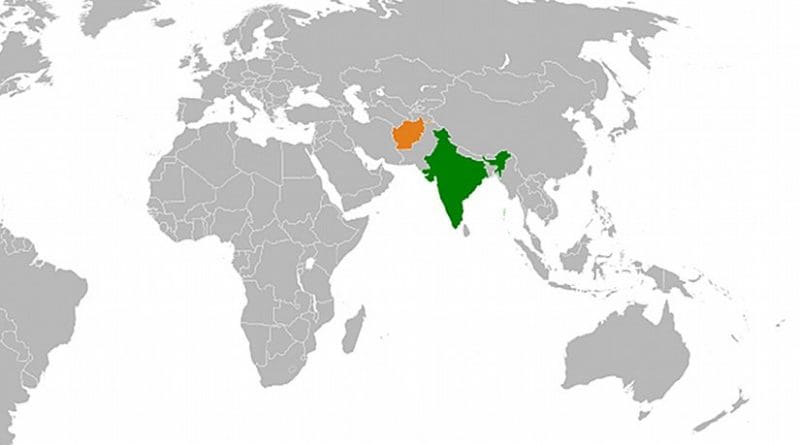India And Afghanistan: Civilizational Friends To Strategic Partners – Analysis
By Chayanika Saxena*
India and Afghanistan as modern, independent nation-states have often attempted to bolster their bilateral ties on the premise of having a collective, common past. And, while these two South Asian states may have charted different journeys since their respective independence, poised at times in opposition to the other, yet the ties between India and Afghanistan have sustained all the ebbs and flows of times, particularly at the popular level.
Both countries stand at contrasting junctures today. Where India is an example of political and economic success with a reasonable degree of social cohesion, Afghanistan remains riven by sectarian conflict, shaky political institutions and an uninspiring economy. As Afghanistan attempts to re-build itself, the help extended by India has contributed a fair share in this process.
The Indian assistance to Afghanistan, which was renewed with the ouster of Taliban in 2001, has strategic, developmental and moral dimensions to it. Where an amount of USD 2 billion has already been spent by India in Afghanistan for its development, another USD 1 billion was assured to it at the 2016 Brussels’ Conference.
Developmentally, India has involved itself in Afghanistan in four sectors: (i) humanitarian assistance; (ii) mega infrastructure projects; (iii) small and community-based development project, and (iv) education and capacity development. The Afghan Shura-i-Milli (National Assembly/Parliament) and Salma Dam in Herat were inaugurated in the last two years, indicating India’s commitment to enable Afghanistan in delivering basic services to its people and ensure rule of law.
Moralistically, there are two clams kept by India in context of guiding the re-development of Afghanistan. First, India believes that it can serve as a model example of political, economic and social success that Afghanistan can take lessons from. Second, it holds that as international gaze turned on Afghanistan to eliminate bases of terror that had been promoted by different countries for their own reason, it has come to vindicate India’s long-standing fight against terrorism, making India a rightful partner of Afghanistan in its quest for peace and stability.
Strategically, the assistance extended by India to Afghanistan is a result of complex bilateral, regional and international equations. Bilaterally, strengthening of strategic ties between India and Afghanistan can (i) help in eliminating terror hideouts that are still being used to execute attacks in both countries, and (ii) provide India access to resource-rich Central Asia. Regionally, India and Afghanistan are aware that their ties are impacted by and leave an impact on Pakistan. Therefore, for India in particular, a strong, stable Afghanistan would come to mean less Pakistani interference in the country, which otherwise has spelt greater troubles for India. Internationally, for India the successful re-development of Afghanistan will serve to bolster its claim of being a rising global power with bilateral and regional pre-eminence.
Following from the potential that strengthened ties between India and Afghanistan hold, the two countries entered into ‘Strategic Partnership’ in 2011 with the aim of “training, equipping and capacity building programs for Afghan national security forces”. Mindful of regional and international sensitivities, this partnership, it is enshrined “is not directed against any state or group of state”. Rather, it delineates Indian interest in ‘cooperative security’ to deal with issues that are of common concern, including terrorism. This partnership agreement is also demonstrative of India’s ‘soft power’ as it lays considerable emphasis on people-to-people ties and social and economic development of Afghanistan alike.
The way ahead for India and Afghanistan as bilateral partners is clear – they want to cooperate. However, punctuated by regional and international dynamics, the path ahead for them is not so straight. There are many scenarios that post-2014 drawdown period has thrown up – (i) an unpredictable Washington, which while has reportedly committed to maintaining troop presence in Afghanistan, can go back on it anytime soon; (ii) emerging alliance between Russia, China and Pakistan over Afghan peace process; (iii) changing opinion of Russia and Iran on Taliban, where reports of assistance and talks have already been reported; (iv) a weakening Afghan state that has effectively lost 50% of its territorial control, and (v) an expanding Taliban whose attacks are getting deadlier and under whose eye, poppy production has increased by 43% compared to 2015. In these circumstances, reinforcement of Indian trust in the Afghan state could mean a lot, yet nothing at the same time.
India has steadfastly maintained that peace in Afghanistan can be re-instated only through a process that is ‘Afghan-owned and Afghan-led’. Adding another dimension to it of late, the Indian government has also sounded that he peace process has to be ‘Afghan-controlled’ as well. In the face of many external alliances and concerts that are emerging to bring peace to Afghanistan, albeit without taking into account the sensibilities of the country, are bound to go no far than the existing ones have. In this context, India’s direct attempts to indirectly assist the Afghan state to bolster its institutions and service delivery mechanisms have not only earned India praises, but they are also enabling Afghanistan to carve a better future for itself.
*Chayanika Saxena is a Research Associate with Society for Policy Studies, New Delhi. This has been excerpted from a SPS policy paper by the author. For a detailed account of evolution of India-Afghanistan ties you can purchase SPS Brief “India re-calibrates ‘strategic ties’ with Afghanistan” (7,700 words). Contact: [email protected]

